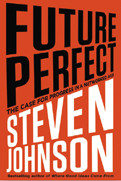
Future Perfect: The Case for Progress in a Networked Age
Steve Berlin Johnson
272 pages, Riverhead Books, 2012
What happens when a metaphor comes to life? The Internet is no longer simply a tool that we use, argues Steven Berlin Johnson is his new book, Future Perfect: The Case for Progress in a Networked Age. We are beginning to apply its core characteristics to our lives, jobs, and communities. Networks, equal access, and read-write (or editable and shareable) products are no longer just core design elements of the Internet; we are making them real.
Johnson describes the creators of institutions modeled after the Internet as “peer progressives.” Like their 20th-century forebears, these are doers intent on solving social, political, civic, and economic problems using readily available tools—in this case, the Internet, mobile phones, and mashable data. They value equity, participation, diversity, and choice. They believe in the power of innovation and are concerned by the dominance of big business and big government. They recognize the peer-to-peer networked structure of the Internet as a general force for good, and they acknowledge that these same structures, used by terrorists, can cause unthinkable harm. They believe most in the power of people to exert the control that’s needed.
This worldview doesn’t fit easily into existing corporate or political structures. The US two-party political system is a particularly tough squeeze for peer progressives, Johnson argues. It is here that he is most convincing. Johnson uses examples of a federal policy on pharmaceutical innovation that mixes elements of a prize contest with an open source approach to sharing solutions to demonstrate how markets, government, innovation, and equal access can all work together. His chapter on liquid democracies, in which people can pool and share their knowledge and votes, fires the imagination about how cherished, established institutions could be revitalized. And his evenhanded navigation between the treacherous shoals of techno-utopia/dystopia is a welcome relief. Johnson is focused on an admittedly small number of examples of peer progressive innovations, which gives his thesis a tone of possibility rather than promising more than he can deliver.
Johnson points to Kickstarter as the essence of peer progressive innovation. He refers to the ethos of crowd creation, funding, and distribution that Kickstarter brings to the creative arts as being evident in experiments in governance, corporate ownership, civic participation, and various media verticals such as technology and political news. The power of peer progressive innovations is not in replacing existing institutions, but in augmenting and complementing them.
Johnson’s argument, that the metaphor of the Internet is being replicated in institutional and behavioral form, will delight techies and activists alike. It pays due attention to the past, and it firmly centers the role of protagonist not on the bits and bytes of digital tools but on the values that were first embedded in the Internet and are now being re-released in “real world” form.
Whether the behaviors and beliefs of the peer progressives constitute an emerging political identity remains to be seen. Regardless, Johnson’s insights resonate powerfully when we consider the social sector. From his opening chapter on the long-term, multivariate nature of progress to his explanation about idea flow, Johnson is describing a set of norms and practices that I believe are the future of nonprofits, social enterprise, and social movements.
In an e-mail exchange Johnson called out one inherent advantage of the social sector when it comes to working in these ways. “Nonprofits have another key asset that allows them to rely on peer networks more naturally than the private sector does, which is that they don’t have a default need to have their ideas be proprietary,” writes Johnson. “So much of the power of peer networks comes from the fact that good ideas are free to flow through the network and be improved upon by other minds.”
Johnson is right about this in principle, though it’s not so clear in practice. More and more of our social goods are produced in hybrid marketplaces with mixed incentives for sharing ideas. Rather than simply assume an easy fit between idea sharing, peer networks, and nonprofits, I’d propose thinking of Future Perfect as an aspirational view of future opportunities.
By wandering far and wide from voting experiments to municipal customer service lines, from crowdfunding platforms to employee-owned businesses, Johnson is seeking common principles in a variety of spheres. What he finds is a set of values that is internally consistent when seen against the shared, open, and collectively mediated nature of the Internet. And, Johnson argues, it is inconsistent with the hierarchical, representative, and closed nature of established corporate forms, business practices, and political parties. As Johnson concludes, this is analogous to the moment before many scientific breakthroughs when “anomalous data start to appear, behavior that doesn’t fit existing expectations.” If he is right, the implications of real-world institutions taking on the characteristics of the Internet will herald a 21st-century progressive age.

